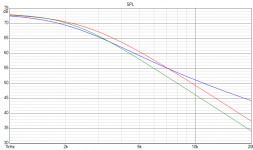Since there is some guessing involved here, can you disconnect the mid driver and see whether it is due to the mid?
Then when you put it back try the reverse polarity to see whether it is happening near the crossovers...
Then when you put it back try the reverse polarity to see whether it is happening near the crossovers...
I've disconnected the tweeter and the problem notes are clearly coming throught the mid range filter. I've also disconnected the midrange and the notes are missing.
So i removed the Mills 4R7 from the mid range Zobel, leaving only the 5.6uF cap in parallel, and the overly bright note are almost gone. Would a different cap value reduce the brightness a tad more?
So I'm learning bits and peices of how XOs work. So is it fair to say the mills resistor was limiting the attenuation?
I didn't know what a "shorted resistor" is so I looked it up and found the following.
I tested my resistors they are 4R7. What do you mean by "Red is with the resistor shorted"?
How To Test whether a Resistor is Shorted
If a resistor is reading a very low resistance, near 0Ω, it's shorted internally. It is defective and, thus, should be replaced.I tested my resistors they are 4R7. What do you mean by "Red is with the resistor shorted"?
Does stating Red is with the resistor shorted essentially mean the resistor is not in the filter?
That's right 😉
So in that case the resonance is a little stronger but the rolloff is a little more steep. The green trace also has the resistor removed, as I did these in the order you suggested.
I've saved that sim if you want to try other things.
So in that case the resonance is a little stronger but the rolloff is a little more steep. The green trace also has the resistor removed, as I did these in the order you suggested.
I've saved that sim if you want to try other things.
If I understand your plot the red curve, at about 3k, is about 2dB louder than the blue and green curves. Yet, when I removed the 4R7 resistor the overly bright/loud notes were reduced and sound much better with the rest of the mid range. Based on that I would have expected the red curve to be lower than the blue curve. What am I not understanding?
Although I should point out that you'll get more accurate results with measured impedance.. I have found that adding more of a small frequency range can help to bring down something that stands out, and in some cases this is the correct thing. After all it is about balancing. Think about how a tweeter on its own can sound, but if you add bass and mid, the treble can become soft and subdued.
So are you saying, even though the mid range filter with the resistor removed would in fact be louder than the filter with the resistor, the tweeter and woofer are effecting the mid range such that the upper piano notes sound softer?
Last edited:
I'm saying that it can, and often does.. if that's the case for you I can only guess. However each piano note has many harmonics spanning a wide range of frequencies. When a small change to the response makes a big change to what you hear, it sometimes means you are getting close. I might guess that if you made this peak even louder then you would begin to hear it on its own, and it will sound lower in frequency than the old peak.
The upper mid range is a bit to bright/loud to blend with the tweeter so I'm going to try your recommendation of increasing the 5.6 cap to 8uF cap. If caps in series equal the sum of both caps I'll add a 2.6uF cap with the parallel 5.6uF cap. Does that make sense?

Last edited:
Thanks AllenB. I added a 2.7uF in parallel with the parallel 5.6uF and it sounds almost perfect. For those of you familar with Keith Jarrett you would know he sings, hums, grunts matching the notes he is playing. Prior to the the 2.7uF cap the upper piano notes were so predominate that his vocie couldn't be heard. With the addition of the 2.7uF I can hear him. So I think I'm close to where I want to be. So I'm going to replace the 2.7uF with a 3.3uf cap. That may make the sound as good as it can get in my system.Put them in parallel to add them. In series they will be 1.8uF
Last edited:
Now I'm thing that, instead of replacing the 2.7uF caps with 3.3uF caps, adding 0.33 or 0.47 dayton caps in parallel will allow finer tweaking. Does that make sense?
I bought a bunch of Dayton Audio pmcp caps, and after expermenting with only the right channel XO, now have a 5.6, 2.7, 2.0 in parrallel. So with 10.3uF the balance of mid range and tweeter sounds quite good. However I'm going try adding a 0.22 and/or a 0.47 to see if that really dials in the balance for me. I'm surprised that it took 10.3 to get close to the sound I want.
- Home
- Loudspeakers
- Multi-Way
- Three way crossover question
